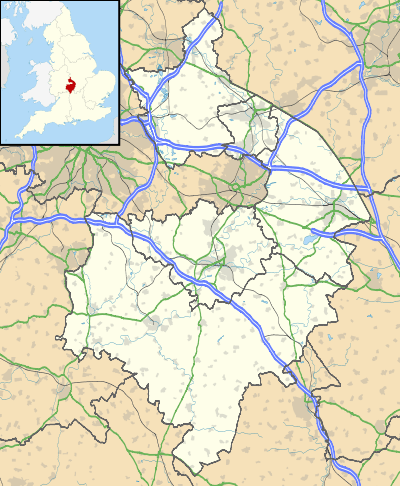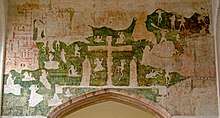Guild Chapel
The Guild Chapel of the Holy Cross, Stratford-upon-Avon, Warwickshire is a chapel of 13th century origins. Founded by the Guild of the Holy Cross before 1269, it passed into the control of the town corporation in 1553, when the Guild was suppressed by Edward VI. The chapel stands on Church Street, opposite the site of William Shakespeare's home, New Place, and has historic connections to Shakespeare's family. The chapel was gifted an extensive series of wall-paintings by Hugh Clopton, an earlier owner of New Place, and John Shakespeare, Shakespeare's father, undertook their defacement in the later 1500s. The paintings have recently been conserved.
| Guild Chapel of the Holy Cross | |
|---|---|
.jpg) The chapel from Church Street | |
| Location | Stratford-upon-Avon, Warwickshire |
| Coordinates | 52.1905°N 1.7077°W |
| Built | 13th century |
| Architectural style(s) | Perpendicular |
| Governing body | Stratford Town Trust[1] |
Listed Building – Grade I | |
| Official name: Guild Chapel of the Holy Cross | |
| Designated | 25 October 1951 |
| Reference no. | 1204554. |
 Location of Guild Chapel of the Holy Cross in Warwickshire | |
Clopton undertook a major expansion of the chapel before his death in 1496, constructing a new nave which was incomplete when he died. The chapel was restored in a thirty-year programme undertaken by Stephen Dykes Bower from 1954-1983 and is a Grade I listed building. Owned and maintained by the Stratford-upon-Avon Town Trust, the chapel is used for services by King Edward VI School.
History
The Guild of the Holy Cross was a medieval religious membership foundation and the guild in Stratford-upon-Avon became a powerful societal force.[2] Members paid fees to join and a range of services were provided, including a hospital and a school, the provision of a priest to pray for the dead, as well as support for the poor. Within the town, the guild constructed its guildhall on Church Street[3] and the adjacent chapel was built circa 1260.[4]
Clopton's wall-paintings depicted a cycle of images[5] showing, among others, the Doom, the Allegory of Death, the Life of Adam and St George Slaying the Dragon. They were covered over by John Shakespeare some time in the 1560s-1570s, acting as town chamberlain and in accordance with Elizabeth I's injunction of 1559 to remove "all signs of superstition and idolatry from places of worship".[6] John Shakespeare's contemporary record details his paying two shillings for "defasyng ymages in ye chapel".[7] The wall-paintings were rediscovered under limewash in 1804[8] and were recorded by the antiquarian and draughtsman Thomas Fisher.[9] A restoration project undertaken in 2016[10] won the Society for the Protection of Ancient Buildings John Betjeman award in 2017.[11]

A major programme of archaeological investigation, carried out by the Department of Archaeology at the University of York in the early 21st century and making innovative use of digital modelling,[12] described the chapel as "one of Europe's most important surviving late-medieval Guild Chapels".[13]
The 'Great Bell', a curfew bell cast in 1633, was renovated in 2018.[14]
Architecture and description
The chancel is 13th century, with the nave and tower dating from Hugh Clopton's rebuilding on c.1490.[15]
Notes
- "Our Estate - Stratford Town Trust - Grant Giving Charity". Stratford Town Trust. Retrieved 2 January 2019.
- "One of the most atmospheric, magical & important buildings in Britain". www.shakespearesschoolroom.org. King Edward VI School. Retrieved 2 January 2019.
- "History". Stratford Town Trust. Retrieved 2 January 2019.
- Pickford & Pevsner 2016, pp. 593-594.
- Rosser 2015, p. 77.
- "The Wall Paintings". Stratford Town Trust. Retrieved 2 January 2019.
- "Internet Archaeol. 32. Giles et al. 2.3 The Holy Cross Guild Chapel". intarch.ac.uk. Internet Archeology. Retrieved 2 January 2019.
- "Ancient Allegorical, Historical, And Legendary Paintings, In Fresco, Discovered In The Summer Of 1804, On The Walls Of The Chapel Of The Trinity, Belonging To The Gilde Of The Holy Cross". www.royalacademy.org.uk. Royal Academy of Arts. Retrieved 2 January 2019.
- "John Gough Nichols (1806-73) - Ancient allegorical, historical and legendary paintings in fresco discovered in 1804 in the Chapel of the Trinity - from drawings by Thomas Fisher". www.rct.uk. Royal Collections Trust. Retrieved 2 January 2019.
- Giles, Kate (2 December 2016). "Why did Shakespeare's father paint over iconic medieval murals?". The Independent.
- "John Betjeman Award celebrates wall paintings at Guild Chapel, Stratford-upon-Avon". The SPAB. Society for the Protection of Ancient Buildings. 5 June 2018.
- "The Use of Virtual Models of Historic Churches". www.buildingconservation.com. Buildings Conservation. Retrieved 2 January 2019.
- "Internet Archaeol. 32. Giles et al. Visualising the Guild Chapel, Stratford-upon-Avon.Summary". intarch.ac.uk. Internet Archaeology. Retrieved 2 January 2019.
- "Stratford upon Avon, Warwickshire". John Taylor & Co. Retrieved 2 January 2019.
- Historic England. "GUILD CHAPEL OF THE HOLY CROSS, Stratford-upon-Avon (1204554)". National Heritage List for England. Retrieved 2 January 2019.
Sources
- Pickford, Chris; Pevsner, Nikolaus (2016). Warwickshire. The Buildings Of England. New Haven, CT and London: Yale University Press. ISBN 978-0-300-21560-1.
- Rosser, Gervase (2015). The Art of Solidarity in the Middle Ages: Guilds in England 1250-1550. New Haven, CT and London: Oxford University Press. ISBN 978-0-1910-1755-1.
External links
| Wikimedia Commons has media related to Guild Chapel of the Holy Cross, Stratford. |